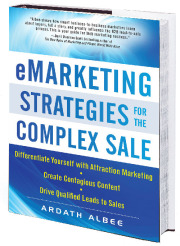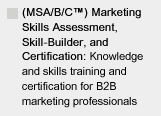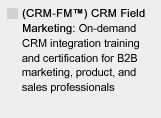MAKE SURE YOU CONTINUE TO RECEIVE EACH ISSUE OF TUESDAY MARKETING NOTES—CLICK HERE TO RENEW YOUR FREE SUBSCRIPTION (IF YOU'VE ALREADY SUBSCRIBED, NO NEED TO RE-SUBSCRIBE)

Why Marketing and Sales Should Be a Joint Venture
Ardath Albee, Marketing Interactions
The B2B marketing-to-sales process can be a long and complex process for your company—as well as your customers. Without agreement for who does what, when, managing the buying process behind the scenes can get messy, fast. Collaboration between marketing and sales teams to develop a joint venture can help to smooth the process and create appreciable results.
Companies that haven't developed an appropriate work flow and process for the disposition and handling of their leads from start to finish put their customer acquisition success at risk by:
• Sending mixed messages to leads that diminish company credibility;
• Mishandling leads and dropping the ball on expectations;
• Wasting their sales reps' time in the pursuit of unqualified leads;
• Unwittingly giving the advantage to better organized-competitors, and more...
A well-orchestrated process with agreement on both sides will foster respect between marketing and sales counterparts by setting the appropriate responses to lead behavior that drive business objectives and productivity. It doesn't hurt at all that the end result is more trust and engagement with leads that become buyers.
You see, your prospects don't care if they're dealing with marketing or sales. What they do care about is gaining access to the right information at the right time in relation to a business problem they're trying to solve. What your leads encounter during the buying process is like a test drive of what their experience as your customer might be like. Regardless of what marketing and sales departments think of each other, to create a consistent and valuable experience for leads, the two departments must figure out how to get in sync.
Since prospects have taken the wheel to steer their buying process, pushing salespeople toward the end stages, this means companies have to make the flow from status quo through purchase decision dynamic and seamless.
Some of the components for managing the buying process that must have agreement between marketing and sales include:
• Lead definition: This includes the demographic and BANT (Budget, Authority, Need, Timeline) items that sales needs to indicate pursuit will be worth their effort. With the expansion of the number of people in the buying committee, it's also prudent to define which influencers may give sales the "foot-in-the-door" they need to move the process forward. For example, if a lead has need and time line, but not budget or signing authority—and activity is high—they're definitely worth a sales conversation;
• Lead score: Overall qualification of leads including scores for definition, activity profile and timeliness of interest. Marketing needs to get agreement from sales on the exceptions to scored behavior that accelerate or decelerate the hand off. By working together to define how a score is attributed, both sides are taking responsibility for the creation of qualified leads. Marketing can guess all they want, but if salespeople aren't getting what they need, they won't work the leads passed to them;
• Trigger event: What prompts the conversion from marketing to sales? Research which behaviors have resulted in other closed deals. A score on its own is often not enough to warrant sales follow-up. For example, what circumstances would prompt a transfer to inside sales instead of field sales? In addition to specific inquiries, trigger events may include online demos, asking a leading question during a webinar, visiting the How to Buy page on your website in addition to other content views;
• Sales response: How long does sales have to follow-up with a converted lead? What is their responsibility for providing feedback to marketing on the status of the lead? Are there times when a lead should be "protected" from marketing to ensure that the conversation with the sales rep is not interrupted?
• Sales returns: What are the criteria for sales returning a lead to marketing for further nurturing? How long is it acceptable for a lead to sit dormant before it should be returned to marketing for further nurturing and qualification? With the cost spent generating leads, we need to make sure that no viable lead gets left behind by closing the loop;
• Nurturing parameters: At what point does marketing stop nurturing and sales pick it up? Or is there a distinction? Perhaps there's a process where—once a lead has been accepted by sales—the lead is placed in a "personalized" nurturing process that appears to be sent by the salesperson. Creating extensions to nurturing programs for sales can result in consistent messaging throughout the buying process that strategically prompts leads to take next steps in concert with sales conversations
These are only a few ideas for structuring a joint venture between sales and marketing. There are many nuances that may be specific to your prospects' buying process and/or your company's culture.
The important thing to remember is that responsibility swings both ways:
• Marketing is on the hot seat to prove that the leads they send to sales are qualified and ready to engage in sales activities with the intent to purchase;
• Sales is on the hot seat to sell. Their responsibility is to share feedback with marketing to help them improve the lead qualification process to ensure that the company's time and efforts on their behalf are not wasted
What would you add or change?
Introducing Ardath Albee's New Book,
eMarketing Strategies for the Complex Sale

|
A comprehensive guide to help marketers drive decisions to buy in their favor.
Power your eMarketing results by mastering how to:
• Build a foundation for eMarketing strategies based on buyer perspectives;
• Use a buyer synopsis to develop personalized content;
• Transform prospect engagement with natural nurturing;
• Create a contagious content structure for competitive differentiation;
• Generate increased pipeline with attraction marketing;
• Facilitate faster prospect progression to sales readiness;
• Perfect the transition of sales-ready leads to your sales force;
• Measure the impact of eMarketing programs against business objectives
To visit this book's Web site, click here . . . |
Ardath Albee (Ardath@marketinginteractions.com) is an expert at creating contagious content and e-marketing strategies that engage prospects-from initial attention until they're sales ready. She has a unique ability to develop content strategies that work hand-in-glove with overall corporate and product positioning to deliver hard hitting e-marketing programs and tools that compel customers to buy. Ardath helps her clients generate more opportunities by optimizing how they leverage marketing automation and CRM technology investments. Her clients include Covad Communications, LANDesk and Silicon Graphics. Visit her website and industry-leading blog to learn more: www.marketinginteractions.com.









